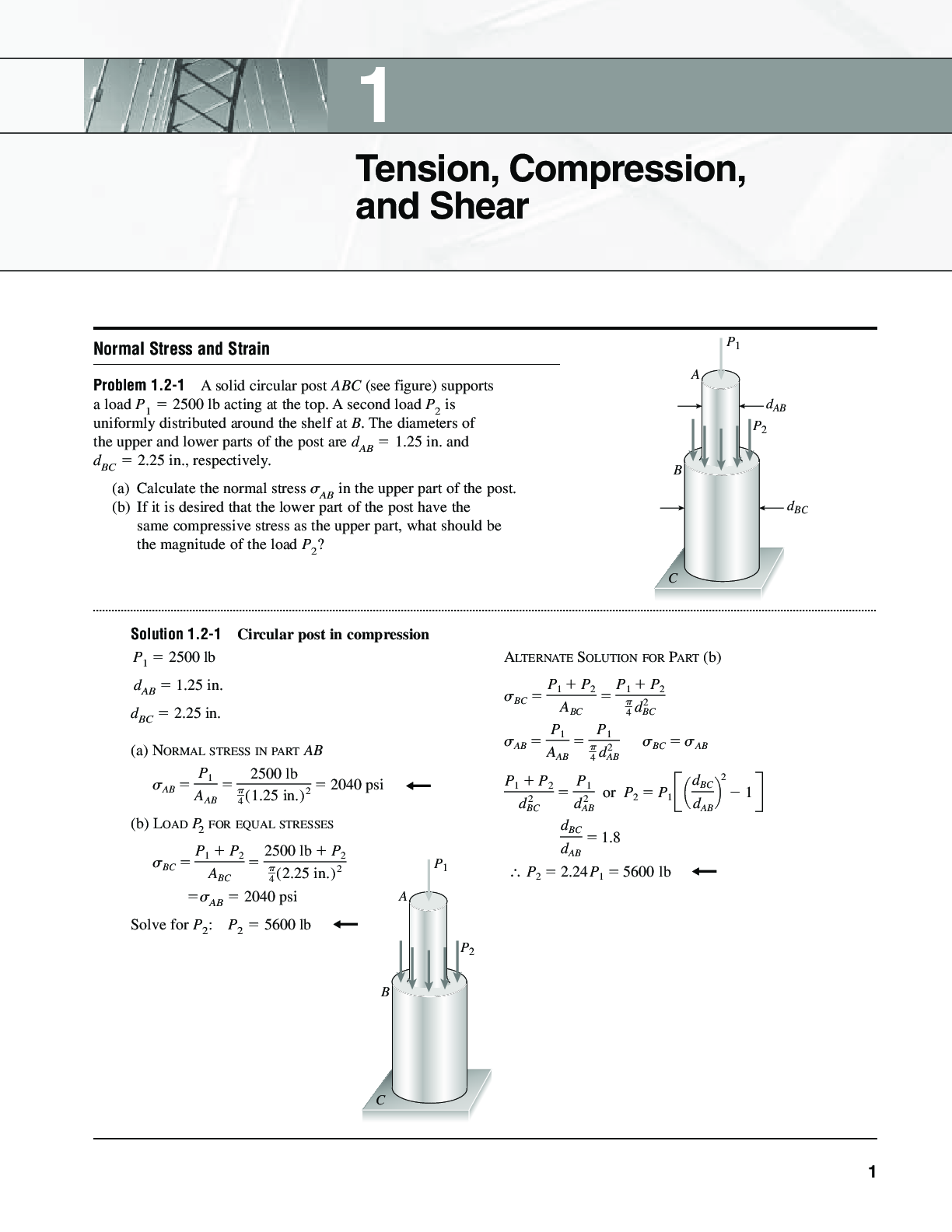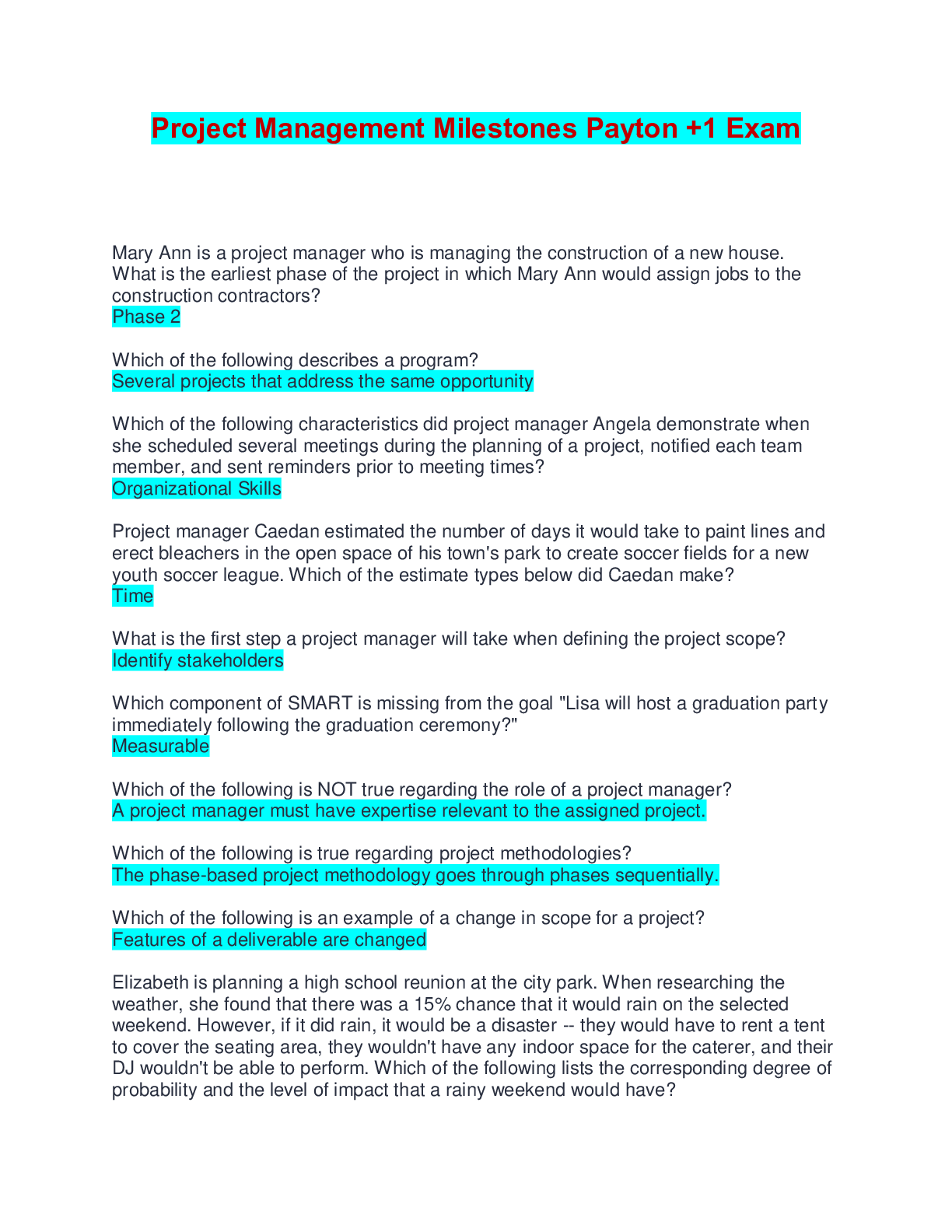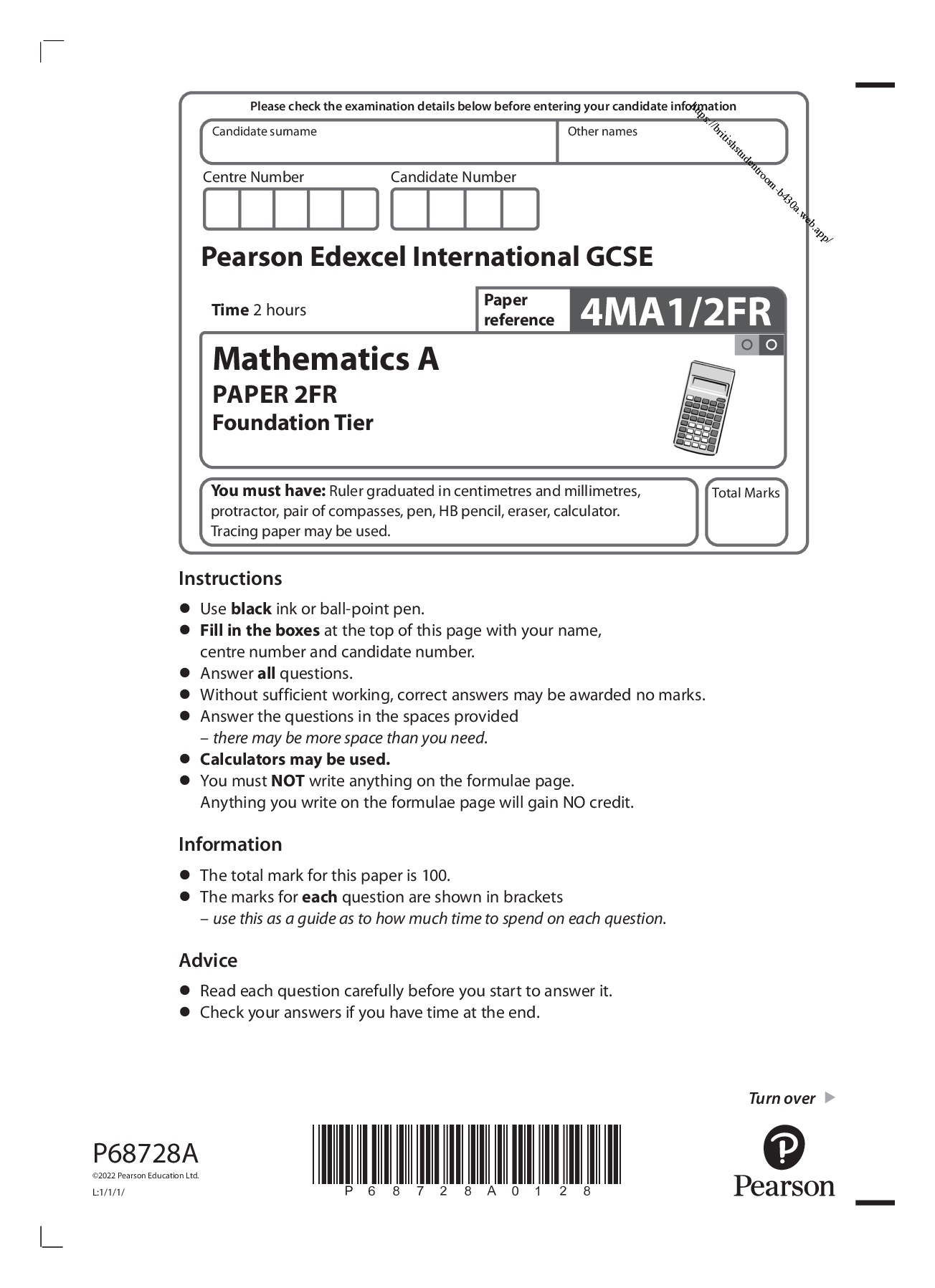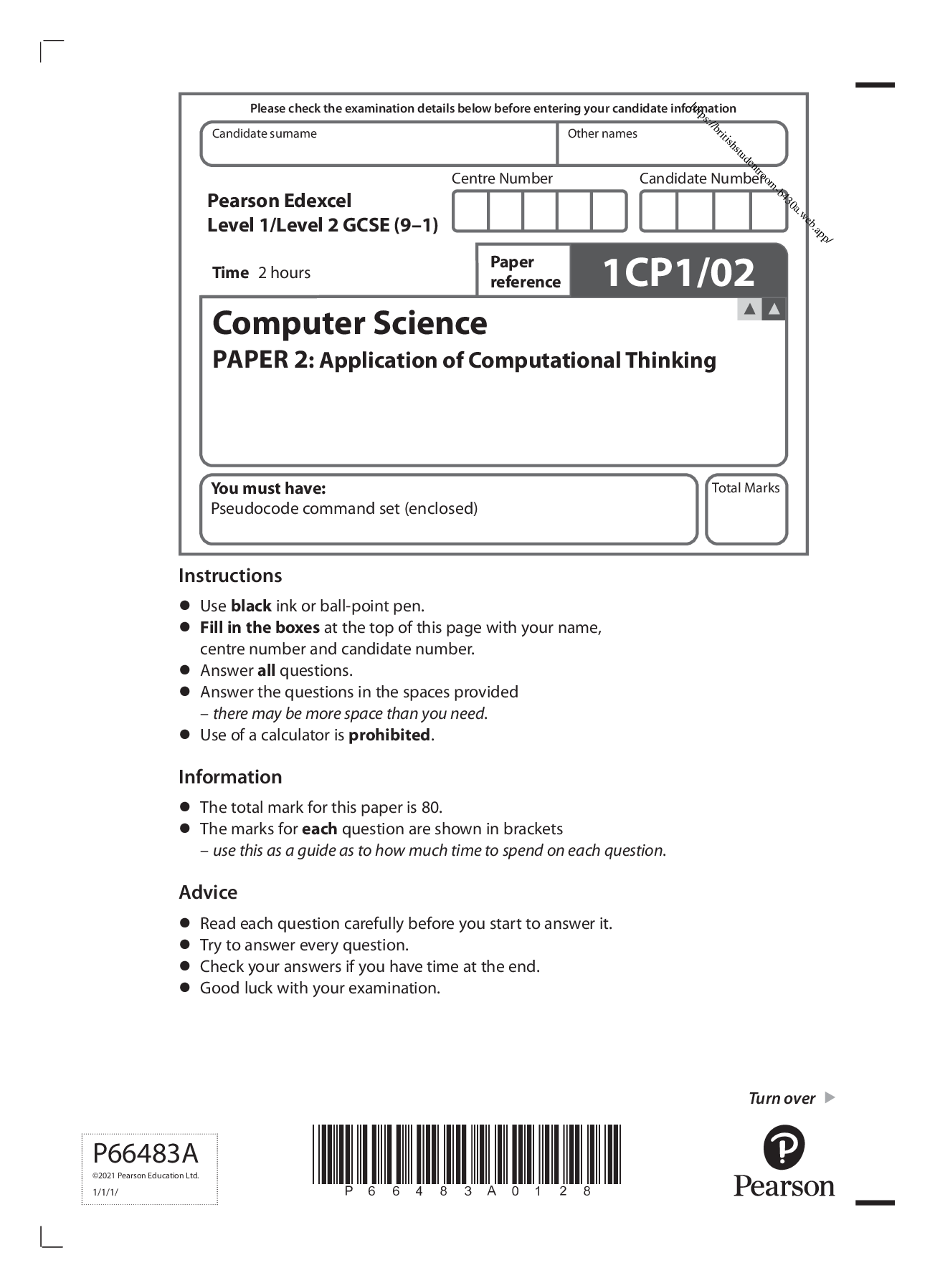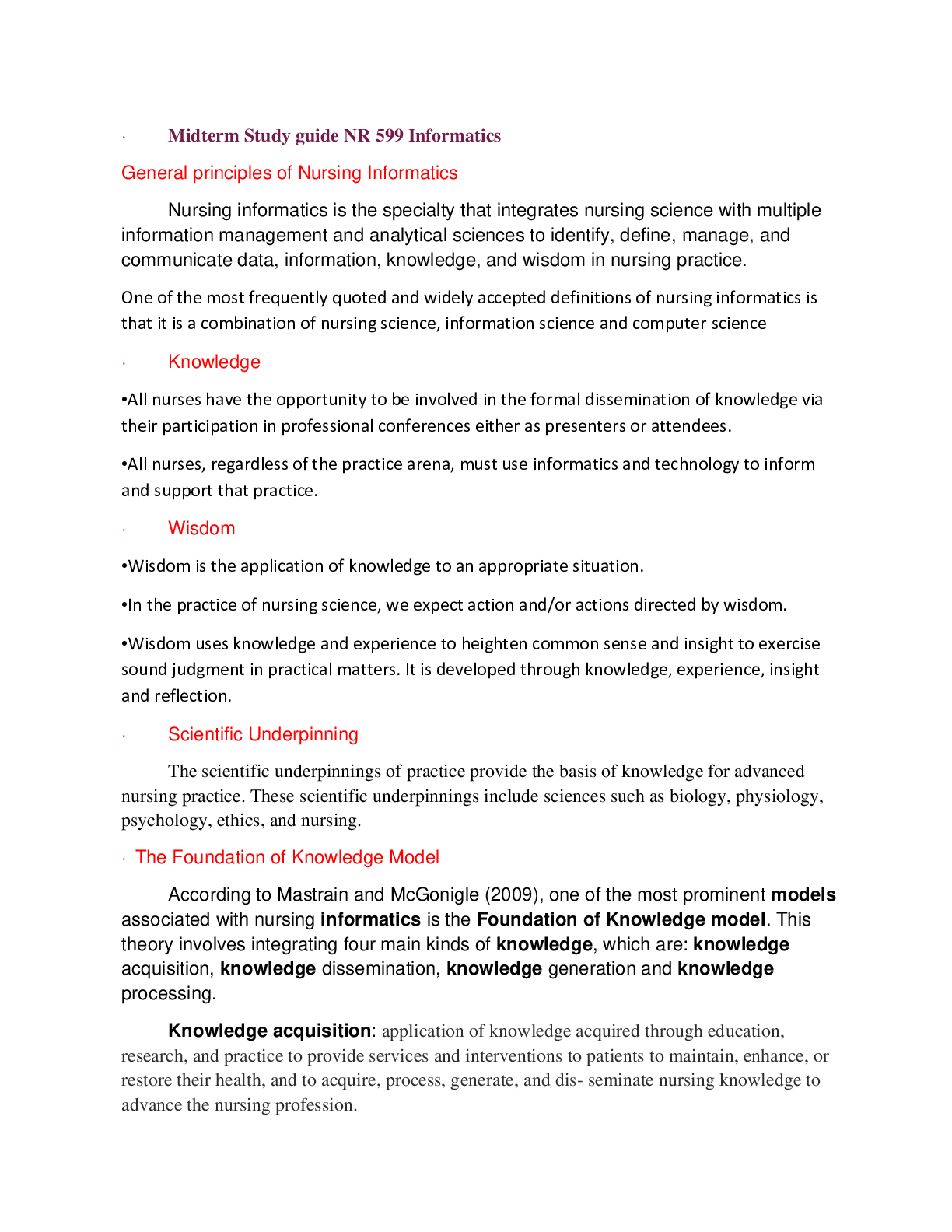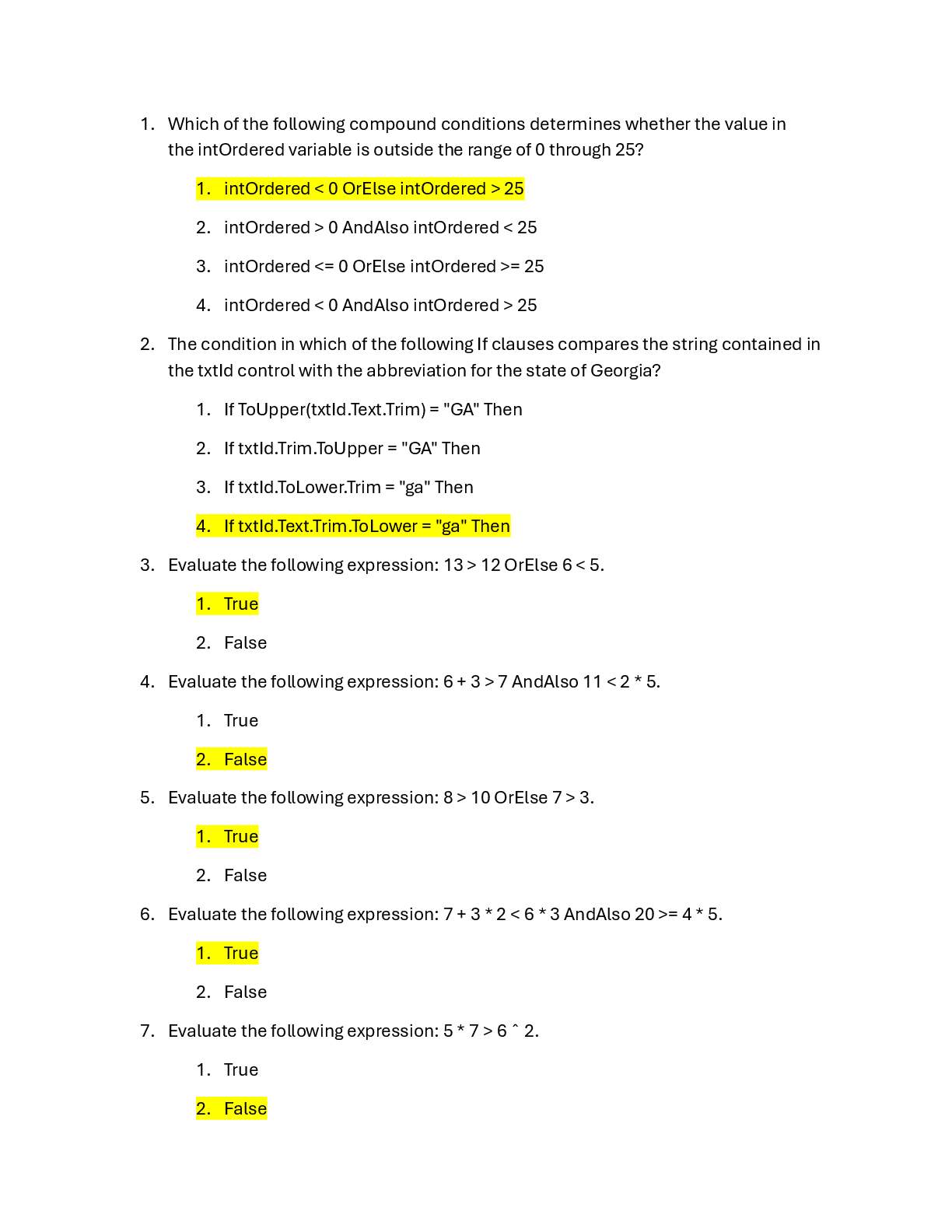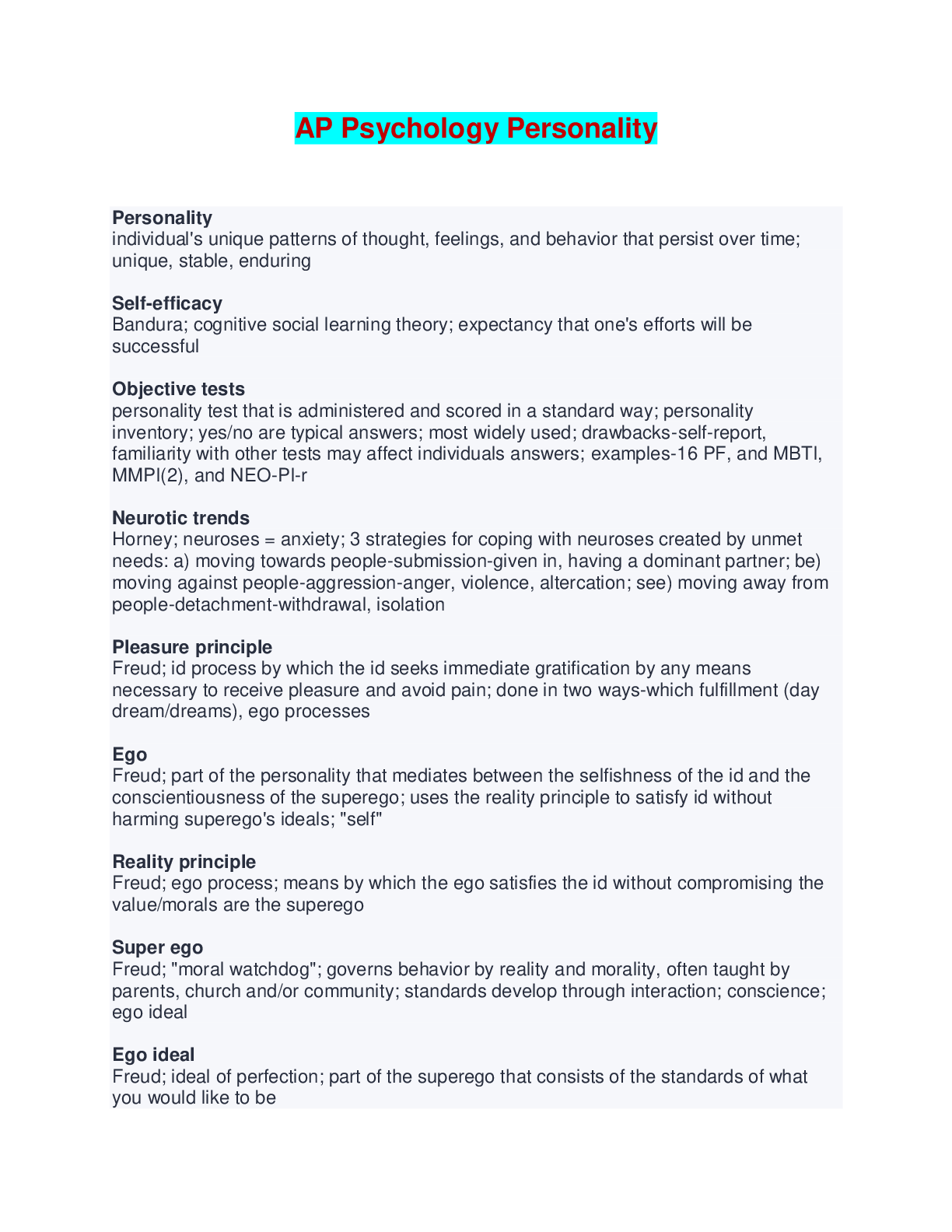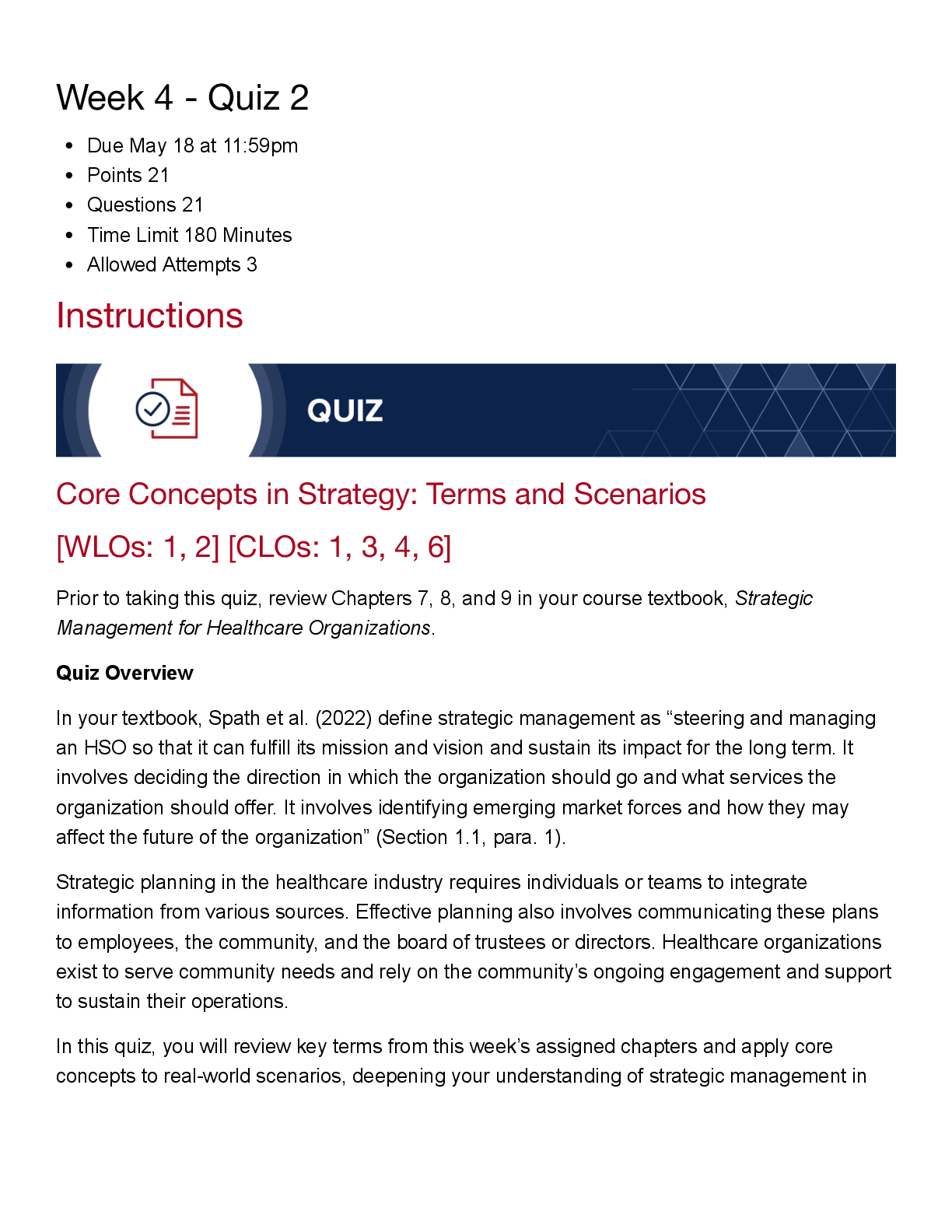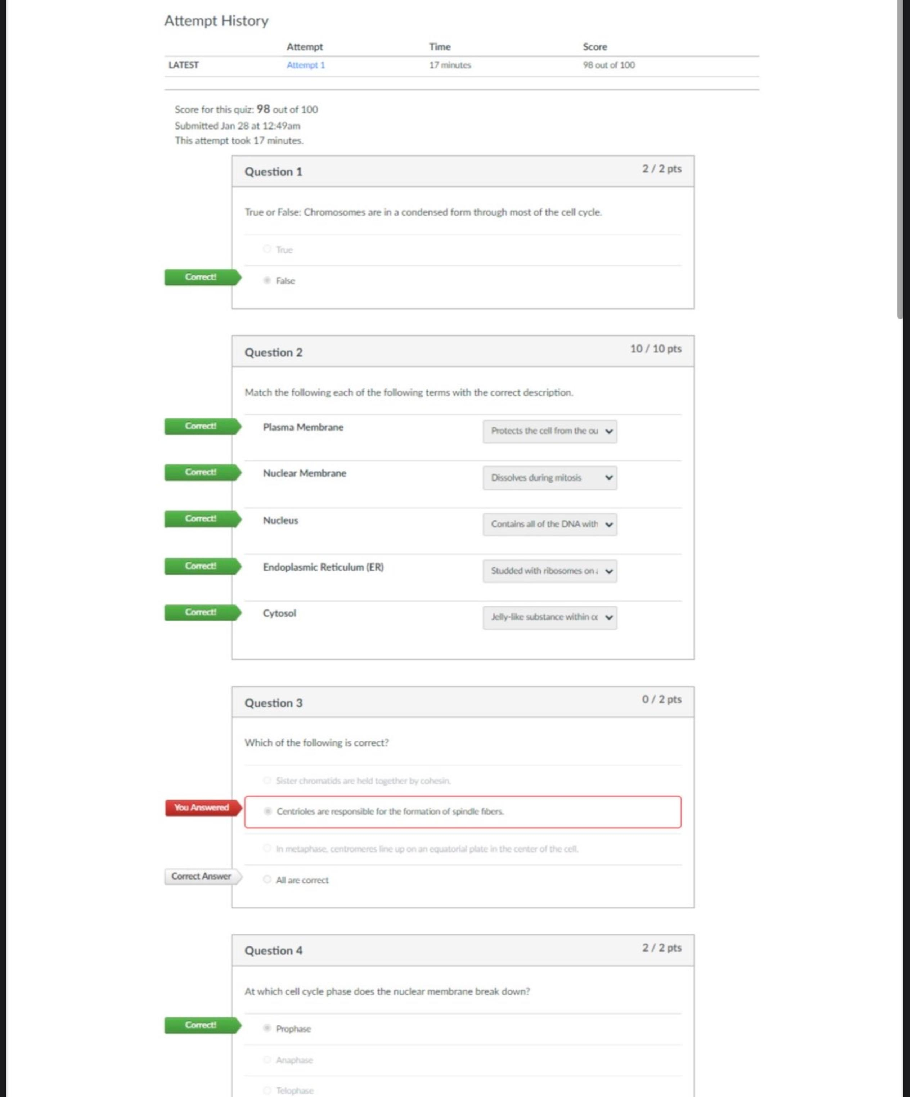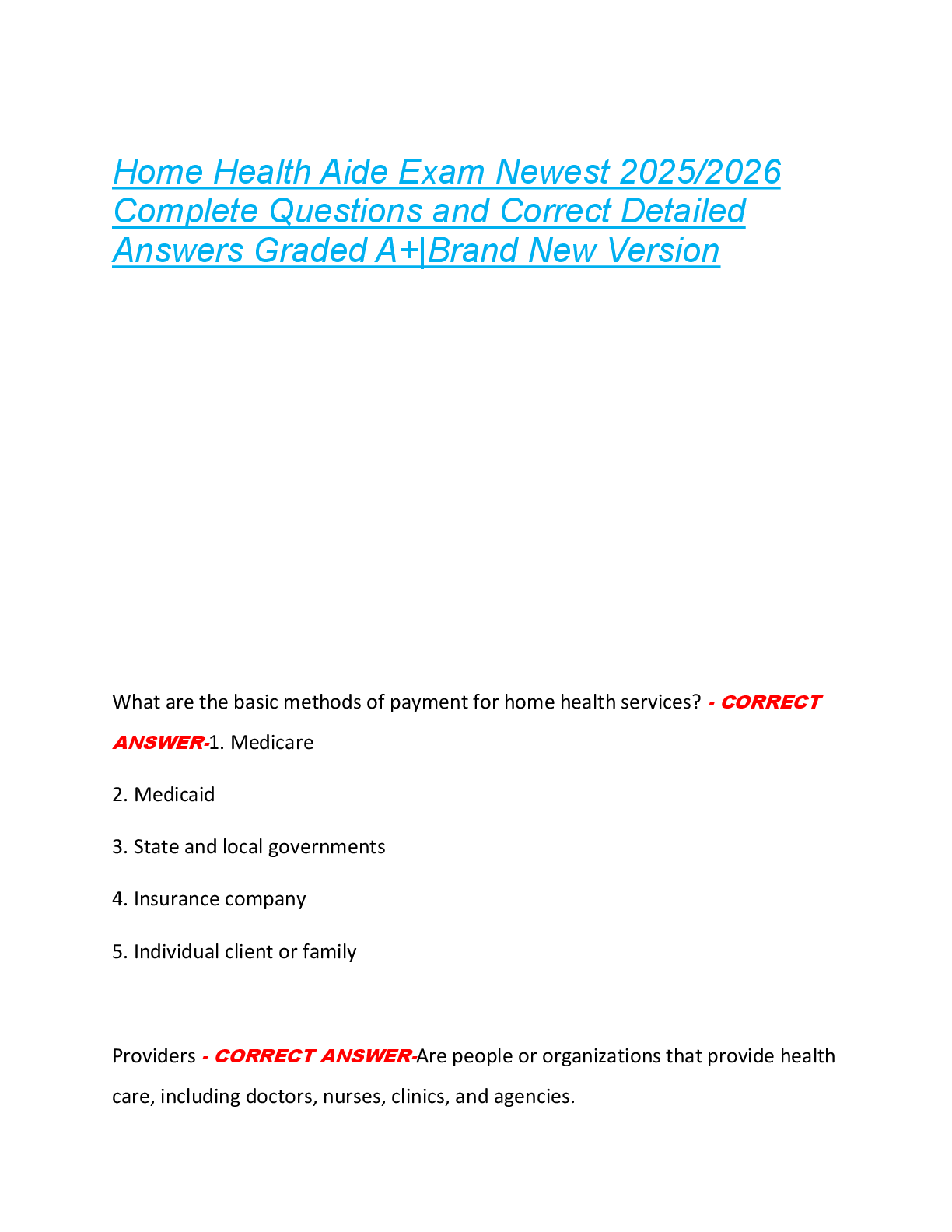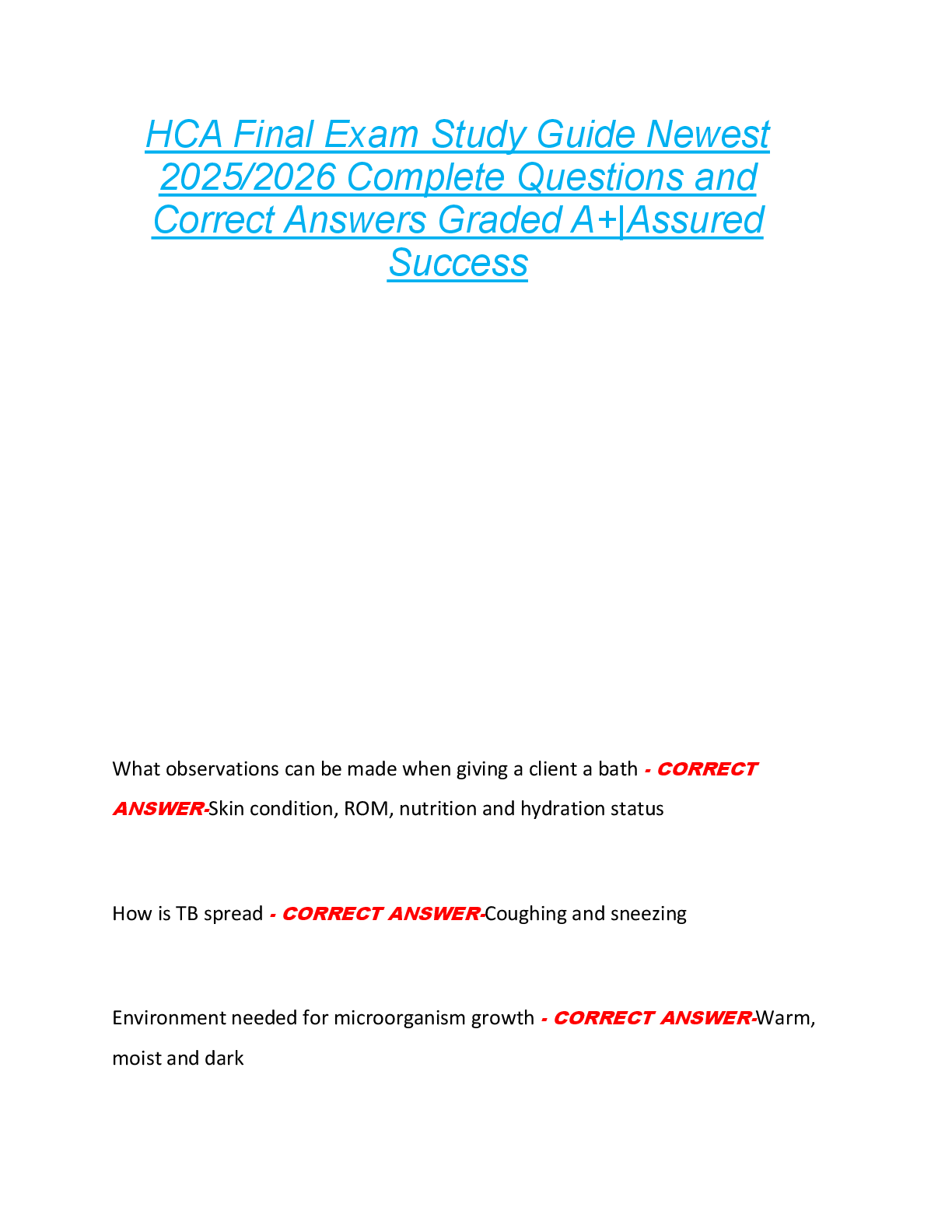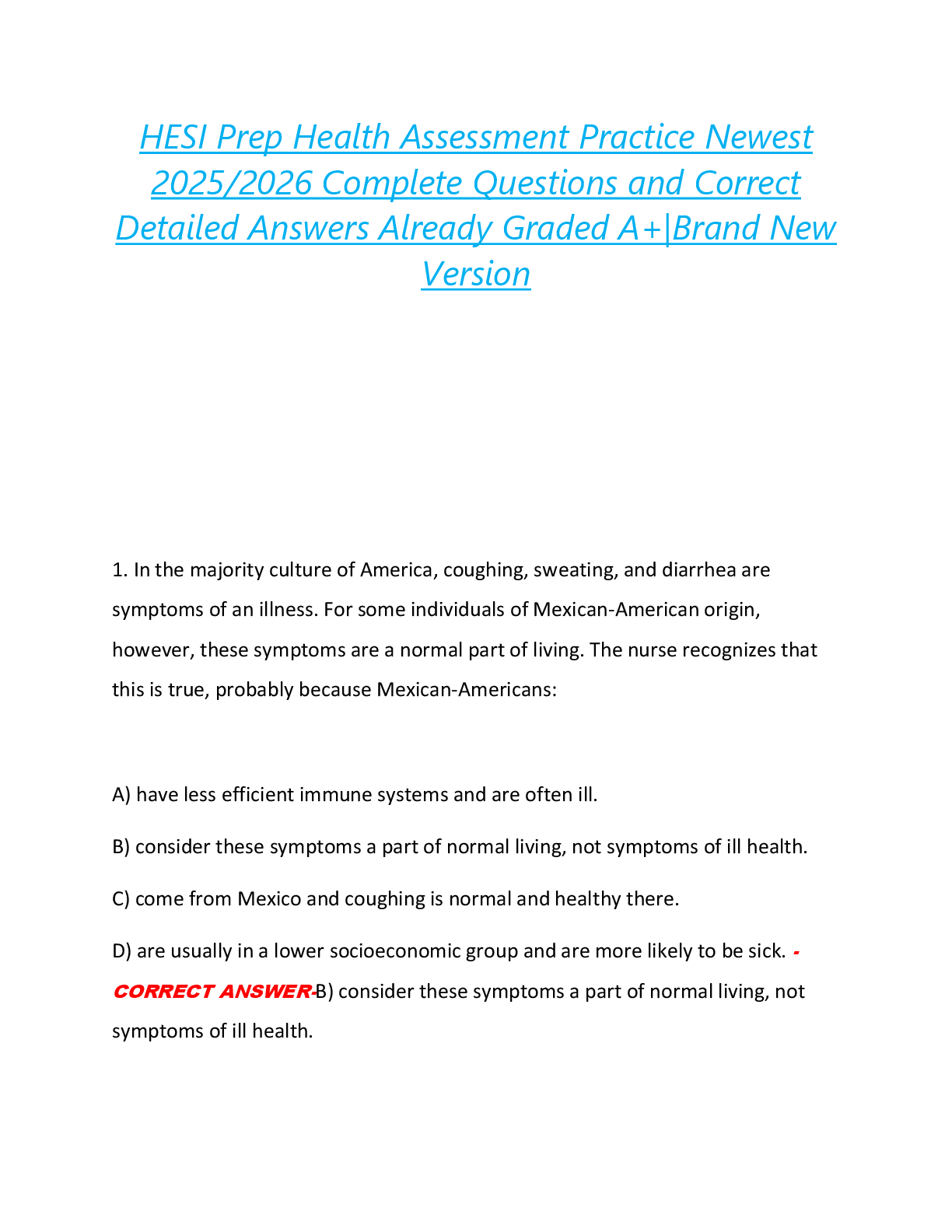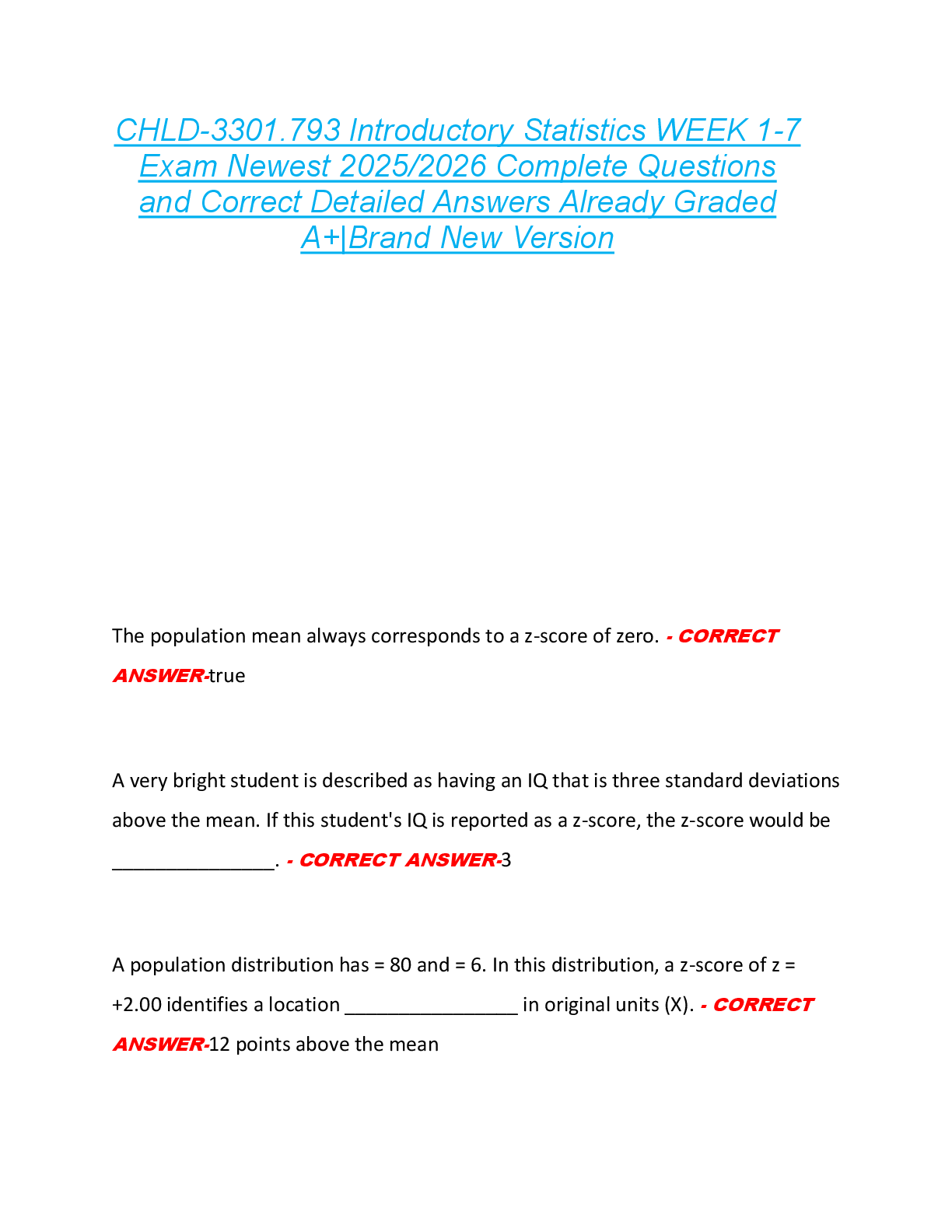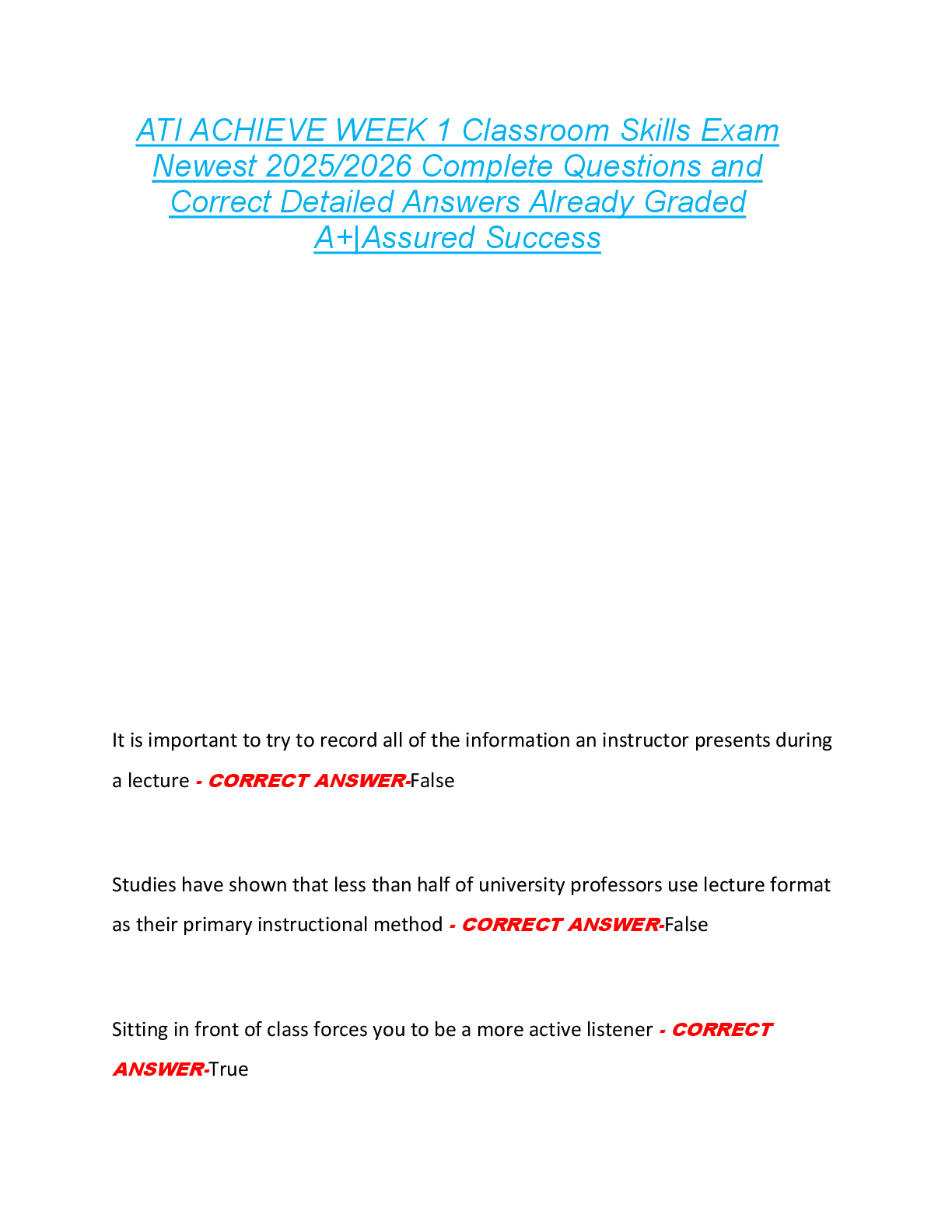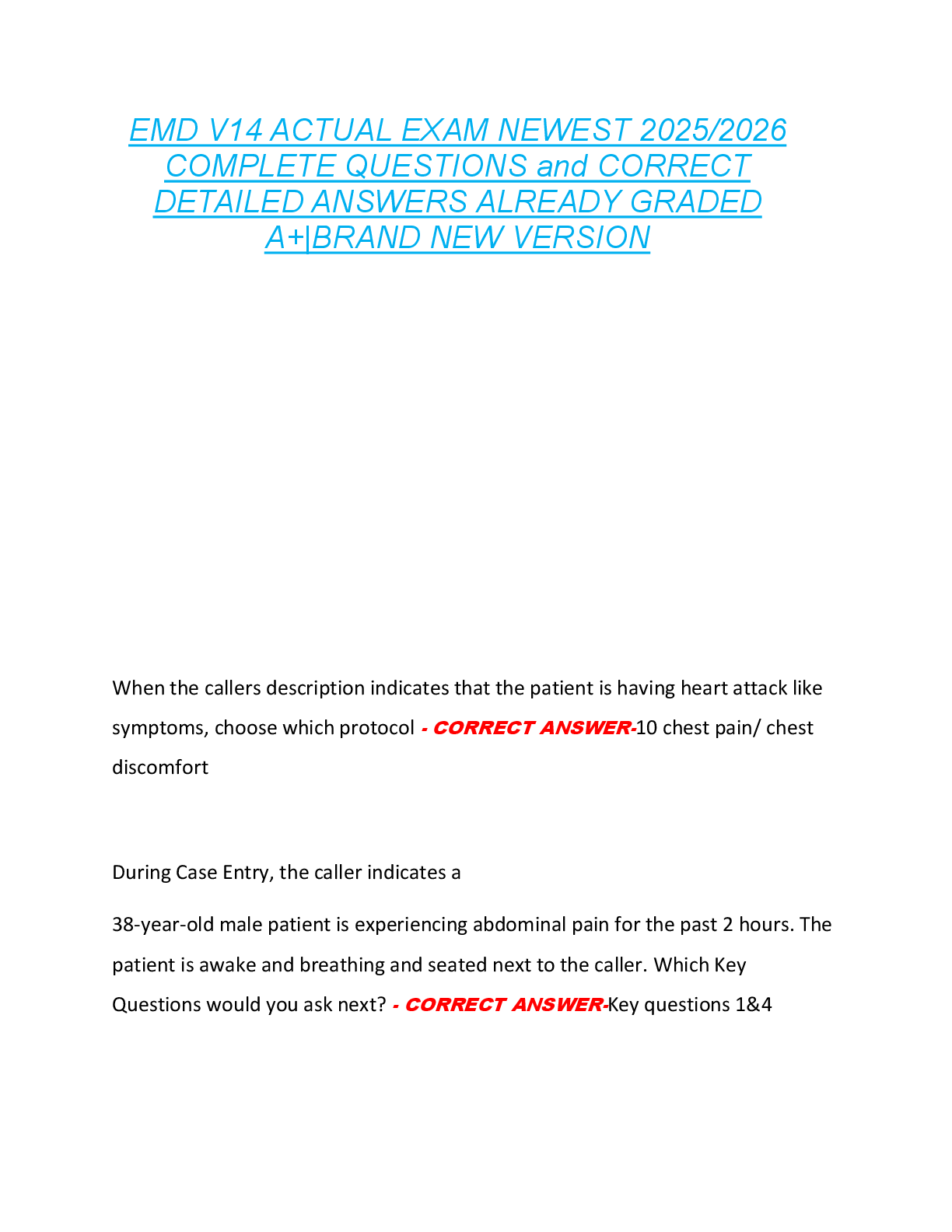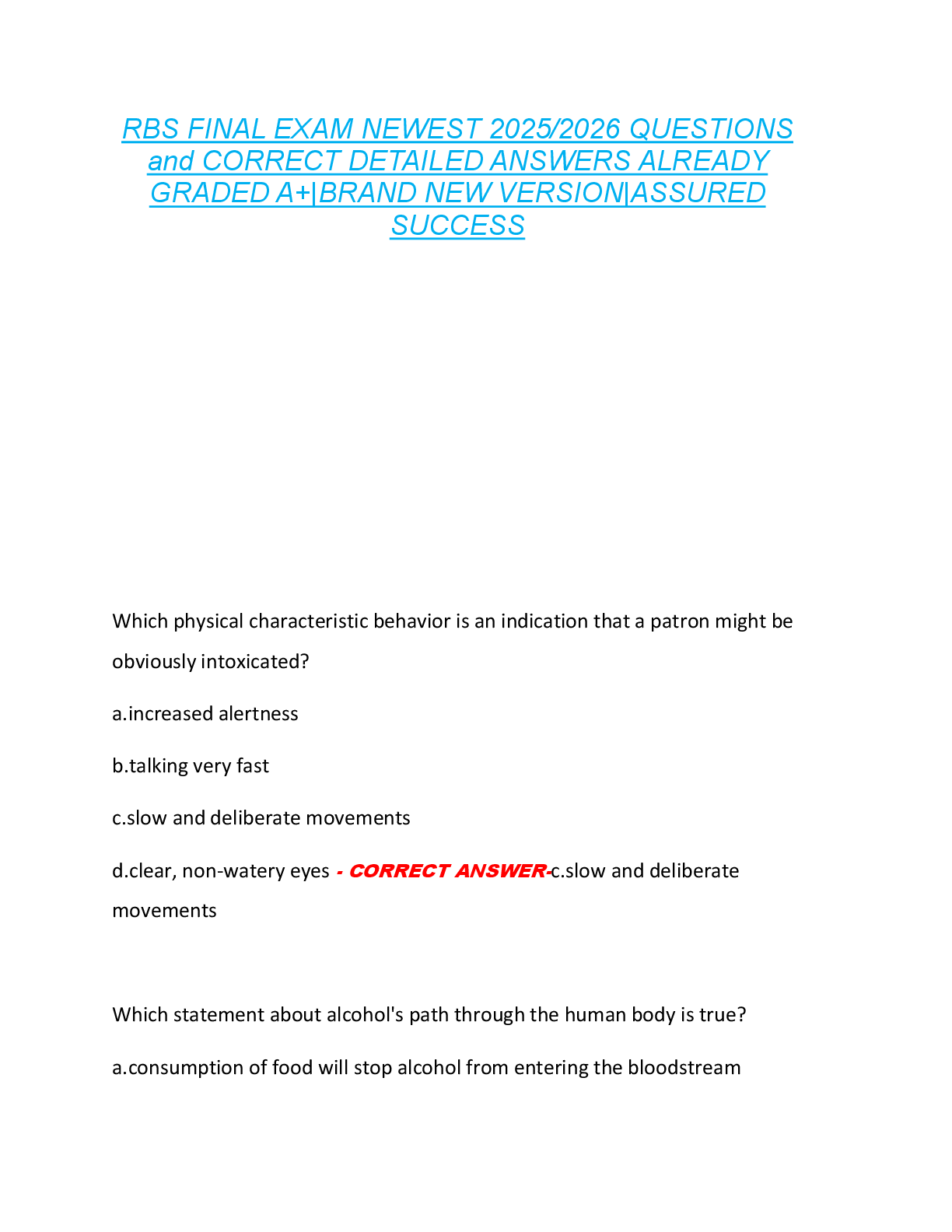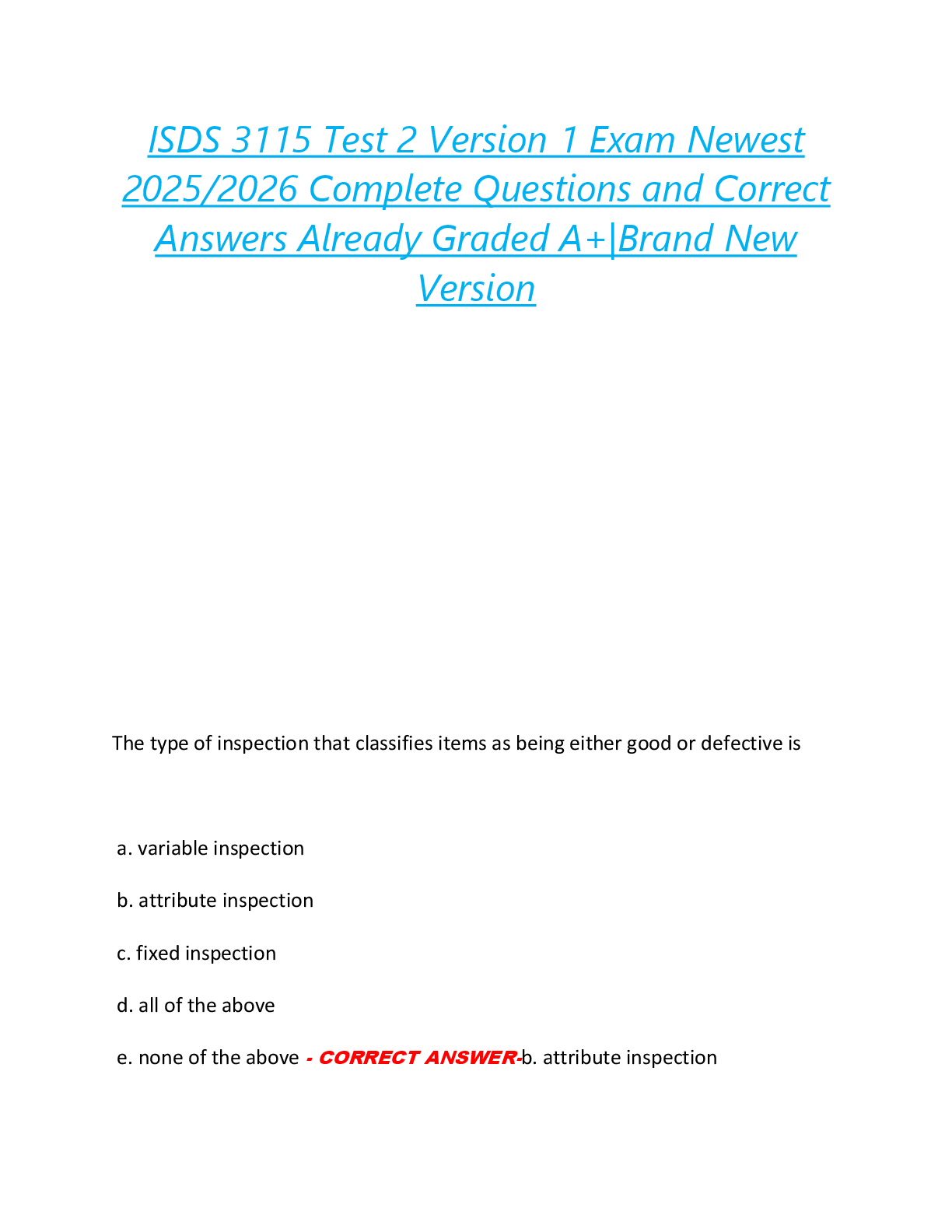ACC 356 Midterm Exam | Complete Solutions (Verified)
Document Content and Description Below
ACC 356 Midterm Exam | Complete Solutions (Verified) Tiffany Evans, a medical doctor and prospective client, has come to your office for the first time. Which is the most appropriate way to greet h
...
er? A. "Welcome to my office." B. "Welcome to my office, Dr. Evans." C. "Hi, Tiffany. Welcome to my office." D. "Welcome to my office, Ms. Evans." Financial planners earn compensation in the form of: 1. A percentage of assets managed. 2. An hourly rate or fee. 3. A commission on investment and insurance products sold. A. 1, 2, and 3. B. 2 only. C. 1 only. D. 1 and 2. During their meeting with you, Johnny and June call the benefits office to adjust their tax withholding to better suit their financial needs. Which of the following stages of the financial planning process is the planner engaged? 1. Analyzing the Client's Current Course of Action and Potential Alternative Courses of Action 2. Monitoring Progress and Updating 3. Identifying and Selecting Goals 4. Understanding the Client's Personal and Financial Circumstances 5. Implementing the Financial Planning 6. Presenting the Financial Planning Recommendations 7. Developing the Financial Planning Recommendations Which of the following is most likely to take place in the Analyzing the Client's Current Course of Action and Potential Alternative Courses of Action step? A. After meeting with David, you prepare his current financial statements. B. During your meeting with Alexis, she provides you with several documents including her employee benefits information and bank statements. C. You provide your client with a description of the fees and costs of your financial planning services. D. In your meeting with Rosie, you sell her a new life insurance policy. Maria Chen has been a client of yours for many years. In your quarterly meeting with Maria, you evaluate her retirement portfolio performance and ensure that progress is being made as expected. Which part of the financial planning process are you engaged in? A. Developing the Financial Planning Recommendations. B. Implementing the Financial Planning Recommendations. C. Understanding the Client's Personal and Financial Circumstances. D. Monitoring Progress and Updating. During your meeting with your client, Hayden Doyle, you recommended he purchase a personal liability umbrella policy (PLUP). Which part of the financial planning process were you engaged in? A. Monitoring Progress and Updating. B. Implementing the Financial Planning Recommendations. C. Presenting the Financial Planning Recommendations. D. Identifying and Selecting Goals. During your meeting with Jeff, you provide him with three education saving plans to choose from. Which of the following stages of the financial planning process is the planner engaged? 1. Analyzing the Client's Current Course of Action and Potential Alternative Courses of Action 2. Monitoring Progress and Updating 3. Identifying and Selecting Goals 4. Understanding the Client's Personal and Financial Circumstances 5. Implementing the Financial Planning 6. Presenting the Financial Planning Recommendations 7. Developing the Financial Planning Recommendations Your client, Donald, provides you with his tax returns from the previous year. Which of the following stages of the financial planning process is the planner engaged? 1. Analyzing the Client's Current Course of Action and Potential Alternative Courses of Action 2. Monitoring Progress and Updating 3. Identifying and Selecting Goals 4. Understanding the Client's Personal and Financial Circumstances 5. Implementing the Financial Planning 6. Presenting the Financial Planning Recommendations 7. Developing the Financial Planning Recommendations Which of the following is usually included in an engagement letter? 1. Defined parties to the agreement. 2. Description of the fees and costs. 3. Time horizon for the work to be completed. A. 1 and 2. B. 2 only. C. 1, 2, and 3. D. 2 and 3. Which school of thought defines mental health as having congruent and aligned thoughts, feelings, and behavior? A. Cognitive-Behavioral School of Thought. B. Humanistic School of Thought. C. Developmental School of Thought. D. The Mental Wellness School of Thought. Which School of Thought requires the financial planner to identify behavioral excesses and inadequacies and try to manipulate these forces to change the client's behavior and thought process? A. The Cognitive-Behavioral School of Thought. B. The Developmental School of Thought. C. The Mental Wellness School of Thought. D. Humanistic School of Thought. Which school of thought has its origin in and was influenced by Freudian psychoanalytic theory? A. The Cognitive-Behavioral School of Thought. B. The Mental Wellness School of Thought. C. Humanistic School of Thought. D. The Developmental School of Thought. Which of the following statements is false? A. Nonverbal cues, or body language, can communicate feelings and attitudes between the client and the adviser. B. Advisers should only use open questions during their client meetings. C. It is important for the advisor to understand the client's values and goals. D. Advisors should strive to be active listeners throughout their sessions with clients. Which of the following best describes the cognitive bias of herding? A. Attaching ones thoughts to a reference point that has no logical relevance or is not pertinent o the issue in question. B. The tendency of investors to believe that they can outperform the market based on their beliefs or skills. C. Individuals that mimic the actions or decisions of a larger group, even though the individual may not have necessarily made the same choice. D. Individuals tend to filter information and focus on information that supports their decisions. Which of the following is probably the start of a closed question? A. Please explain whether ... B. Why ... C. Isn't it true that ... D. How ... Making a decision based on whatever information exists in your memory bank best describes which of the following: A. Availability Heuristic. B. Similarity Heuristic. C. No answer text provided. D. Affect Heuristic. All of the following are principles of Modern Portfolio Theory except: A. Investors are rational. B. Returns are determined by risk. C. The Mean-variance portfolio theory governs. D. Markets are inefficient. Which School of Thought postulates that humans are subject to the same learning principles that are established in animal research? A. The Cognitive-Behavioral School of Thought. B. The Pavlovian School of Thought. C. The Developmental School of Thought. D. The Humanistic School of Thought. An example of internal data is... A. The current tax rates. B. The client's goals. C. The planner's education. D. The expected inflation. Which step in the financial planning process comes before monitoring? A. Presenting the plan. B. Implementing the plan. C. Gathering data. D. Analyzing the client's financial status. If your financial planning client uses phrases like: "see what I mean" or "imagine that," your client's learning style is most likely... A. Neither auditory nor visual. B. Auditory. C. Both auditory and visual. D. Visual. External data collected in the financial planning process includes all of the following except: A. Current and prospective interest rates. B. Expected rate of increases in the prices of education and medical care. C. Education goals of the family. D. Information about the business cycle. Which of the following best completes this sentence: There has been a movement in recent times for the financial industry to be more in touch with _____________ due to their effect and persuasiveness in financial matters. A. Beta. B. Warren Buffett and Bill Gates C. Capital Asset pricing. D. Psychology and sociology. Which of the following options best completes this sentence: "In the event that a client is trying to communicate a message that is not clear, then the advisor will want to ..." A. Clarify what the client is trying to communicate with a clarifying statement. B. Move on. C. Reschedule the meeting for another day. D. Take a break. One of the most reported interruptions or disruptions in passive listening is when: A. he speaker takes too many breaks. B. A seminar moderator interrupts the presentation. C. The listener is thinking about what he or she may say in response to what is being discussed while the listener should instead be listening. D. A friend asks you questions about the presenter's speech. Which of the following is likely the beginning of a closed question? A. Can you...? B. Was it....? C. Why did you? D. Is it true that....? Which of the following theories or equations govern the premises of Traditional Finance: 1. Bottom Line Theory. 2. Prospect Theory. 3. The Behavioral Asset Pricing Model. A. 1 and 3. B. All three. C. None of the three. D. 1 only. Which of the following stated goals of a client is the most workable for financial planning purposes A. Of greatest importance, to save enough to pay $10,000 per year for four years for college tuition expenses for each of our three children. B. To have adequate insurance protection. C. To get out of debt. D. To enjoy vacations at various locations outside the U.S. The benefits that accrue to a client from using a financial planner to prepare a financial plan include all of the following except: A. The financial planner is subjective and knowledgeable. B. A professional planner will include metrics. C. A financial planner will identify risks in the process. D. Increased awareness on client's part as to opportunity costs. The idea that people value gains and losses differently is an example of: A. Confirmation Bias. B. Gambler's fallacy. C. Hindsight Bias. D. Prospect Theory. Which of the following best describes Behavioral Finance? A .Behavioral Finance is very similar to Traditional Finance in its asset pricing models and portfolio theories. B. Traditional Finance's introduction of scientific method into financial analysis has some benefit to Behavioral Finance. C. Behavioral Finance concepts are more developed than Traditional Finance. D. Behavioral Finance streamlined financial data. Which of the following do NOT apply to the use of questionnaires? A. They can be very thorough and cover many areas that must be covered during the acquisition of quantitative information from the client. B. They provide quick and easy information. C. Long questionnaires are most desirable. D. They ensure that subject areas are not left out or forgotten by the advisor. Slippery roads after a rainstorm are an example of a: A. Morale Hazard. B. Physical Hazard. C. Morale Peril. D. Physical Peril. Which of the following is not a valid method for determining life insurance needs? A. The Dependency Method. B. The Human Life Value Method. C. The Financial Needs Method. D. The Capitalization of Earnings Method. Which of the following statements is/are correct? 1. Term life insurance is considered "pure insurance." 2. Term life insurance premiums are significantly more expensive than premiums for permanent policies. A. Both 1 and 2. B. Neither 1 or 2. C. 2 only. D. 1 only. Which part of the personal automobile policy (PAP) addresses uninsured or underinsured motorists? A. Part A. B. Part B. C. Part C. D. Part D. Which of the following measures is appropriate for a risk that has a low frequency of occurrence and a high severity? A. Avoid Risk B. Transfer/Share risk. C. Reduce risk. D. Retain risk. Insurance, as a contract, is adhesive, meaning: A. What is paid by the insured and paid out by the insurer may not be equal amounts. B. Only the insurer is making a promise. C. The insured had no opportunities to negotiate terms. D. The coverage is conditioned upon the payment of premiums. Which of the following statements is/are correct? 1. Loss frequency refers to the potential size or financial damage of a loss. 2. Loss severity is the expected number of losses that will occur within a given period of time. A. 1 only. B. Neither 1 or 2. C. Both 1 and 2. D. 2 only. In a disability policy, the time between the disability event and the point at which benefits, under the contract, begin is known as the: A. Wait Room Period. B. Elimination Period. C. Discount Period. D. Disabled Period. Which of the following is NOT true of insurable risks? A. A large number of similar exposures must exist. B. Risks can be insured even if they are not measurable or determinable. C. Insured loses must be accidental. D. The loss must not pose a catastrophic risk for the insurer. When fine arts or gun collections are insured under a homeowners policy by endorsement, A. The perils covered are the same as the homeowners policy to which the endorsement is attached B. Coverage is usually on a replacement cost basis C. Coverage is usually provided on an agreed to valued basis D. Coverage is usually on an actual cash value basis The predetermined value is placed on such objects. If the loss is total, the insurance company pays the face value of the policy (predetermined). This is contrasted to the usual actual cash value or replacement cost coverage. The perils covered are the same as the homeowners policy to which the endorsement is attached is not correct with respect to endorsements. Loss severity is the: A. Probability that a liability judgment may exceed an individual's net worth B. Probability that a particular property could be totally lost C. Probable size of a loss that may occur D. Probable number of losses that may occur "Probable size of a loss that may occur" is the definition of loss severity while "Probable number of losses that may occur" is the definition of loss frequency. Which of the following is not a response to a perceived risk? A. Risk avoidance B. Risk transmission C. Risk transfer D. Risk retention E. Risk reduction Risk transmission is a false term while Risk avoidance, Risk Reduction, and Risk retention, and Risk transfer are the four responses to a perceived risk. An HO-3 policy ("open perils" except those specifically excluded) with no endorsements excludes which one of the following perils? A. Flood B. Fire C. Collapse D. Weight of ice Which of the following is not a methodology used to determine the amount of necessary life insurance? A. The Ways and Means Method B. The Financial Needs Method C. The Capitalization of Earnings Method D. The Human Life Value Method Lenny works at a hotel in accounting. He is planning on purchasing a home and has met with an insurance agent. However, he is really not clear about all the policies that they discussed. Which of the following statements is correct? A. It is important to get a homeowners policy that provides for contents protection equal to actual cash value B. The rates on auto insurance are relatively uniform among the states C. It is better to purchase a named peril homeowners policy D. PLUPs are generally inexpensive relative to the coverage they provide The statement "It is better to purchase a named peril homeowners policy" is incorrect as an open peril policy will cover more risks. The statement "The rates on auto insurance are relatively uniform among the states" is incorrect as auto insurance rates are very different from state to state. The statement "It is important to get a homeowners policy that provides for contents protection equal to actual cash value" is incorrect as it is better to have replacement cost for contents instead of actual cash value. That leaves statement "PLUPs are generally inexpensive relative to the coverage they provide" as the correct choice. Which of the following statements regarding life insurance needs is / are correct? 1. The human life value approach looks forward for information. 2. The capitalization of income approach looks at right now only for information. 3. The needs approach looks at future needs of dependents but does not consider the estate that the decedent would have built had he lived. A. 1, 2, and 3 B. 1 and 2 C. 1 and 3 D. 1 only All statements are correct. The needs approach assumes no estate built during the life of the decedent. Brea is looking for an insurance policy for her car. Her friend, Justin, who is an attorney, just told her that the policy is a contract and has some unique characteristics. Which of the following terms applies to the insurance contract? 1. Unilateral 2. Aleatory 3. Adhesive A. 2 only B. 1 and 2 C. 1, 2 and 3 D. 2 and 3 All of the terms apply to an insurance contract. It is unilateral - Only the insurer is making a promise, therefore it is a unilateral contract. It is aleatory - What is paid in by the insured and paid out by the insurer may not be equal amounts. It is adhesive - The insured had no opportunity to negotiate terms; thus ambiguities are charged to the insurer.
[Show More]
Last updated: 1 year ago
Preview 5 out of 30 pages






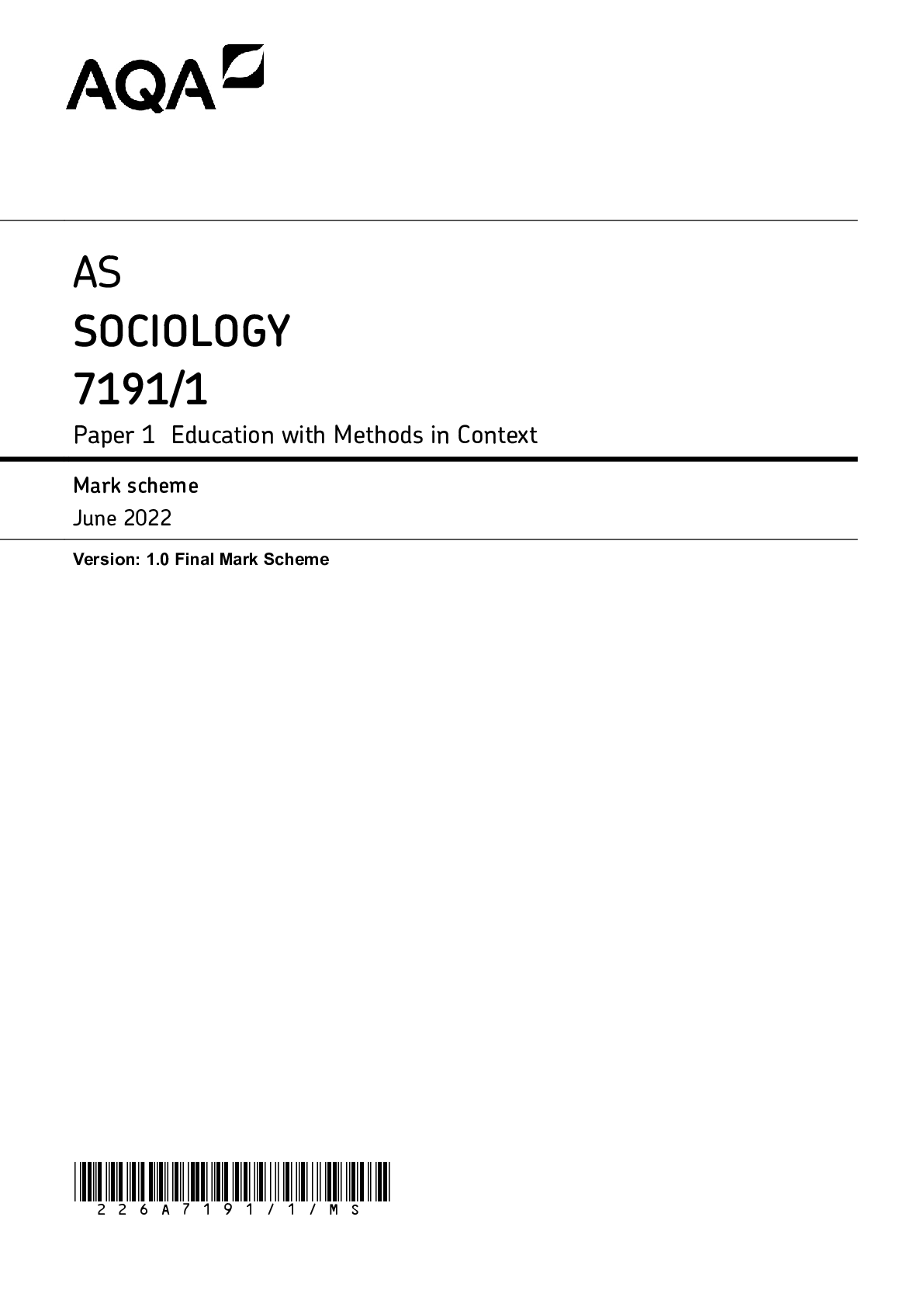






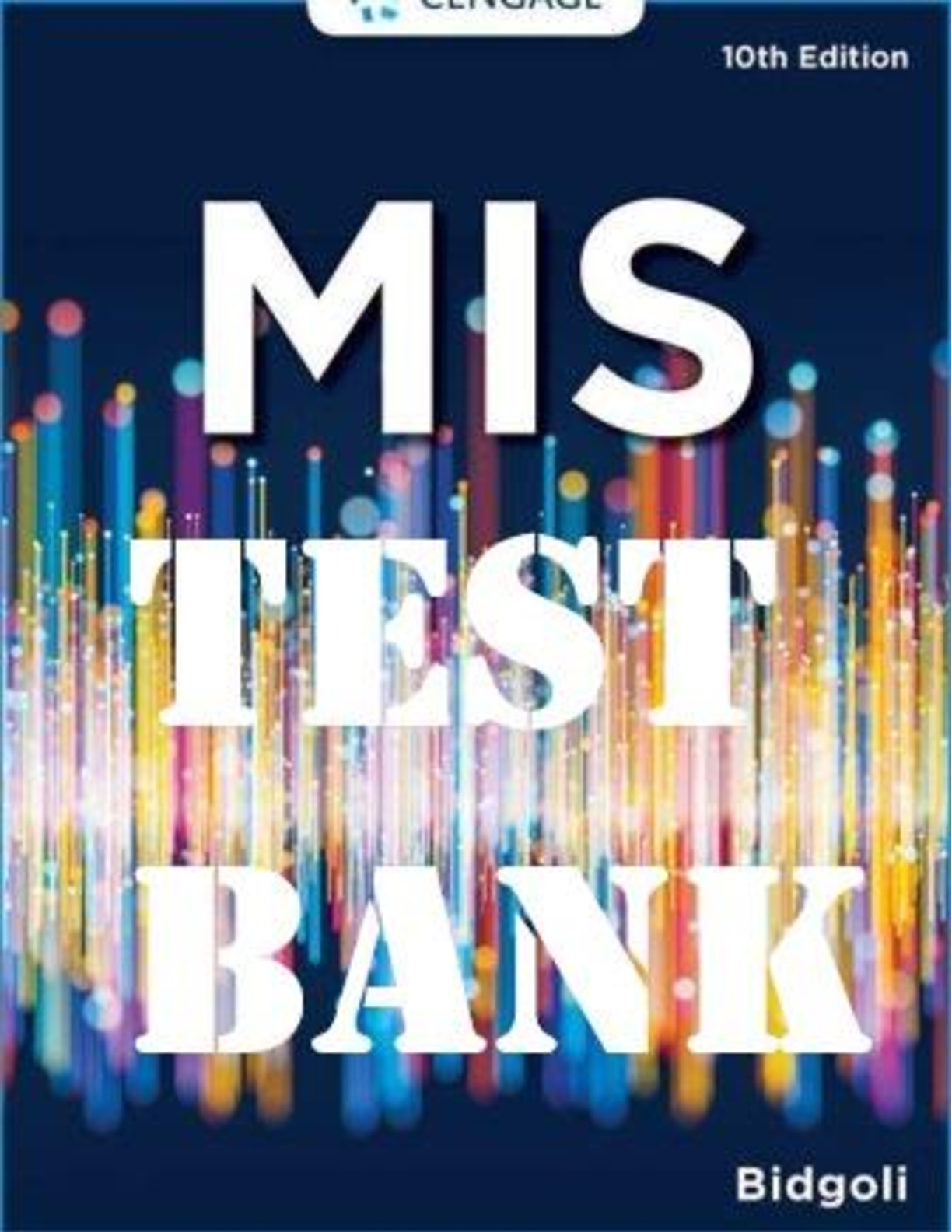
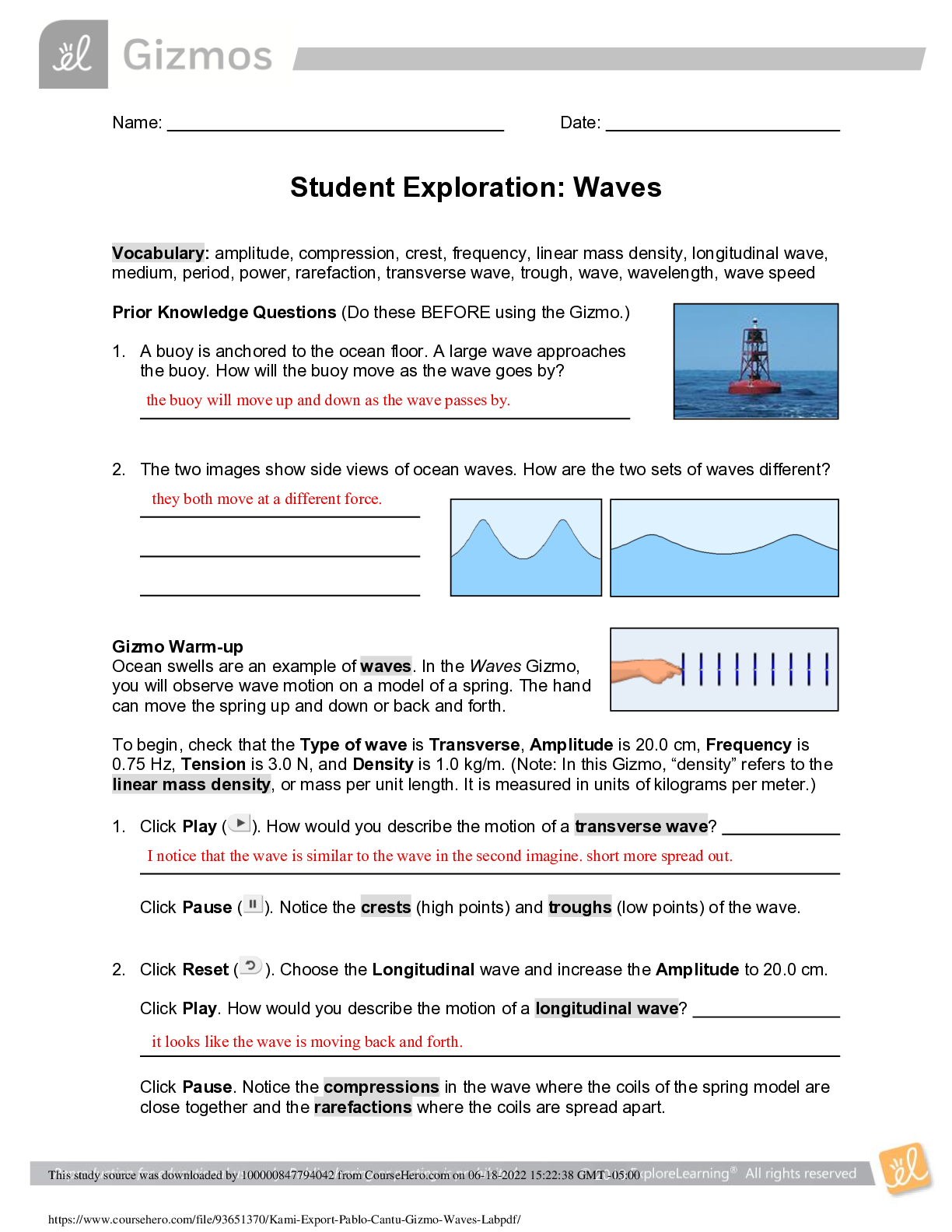




 (1).png)


.png)

